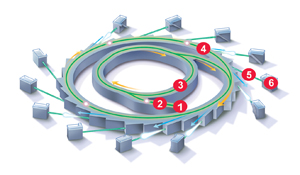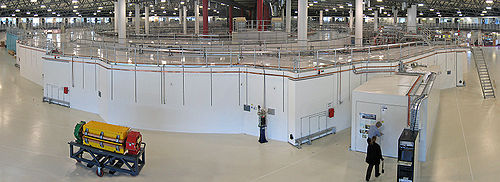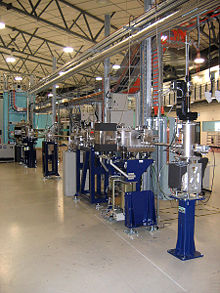
Australian Synchrotron
Encyclopedia

GEV
GEV or GeV may stand for:*GeV or gigaelectronvolt, a unit of energy equal to billion electron volts*GEV or Grid Enabled Vehicle that is fully or partially powered by the electric grid, see plug-in electric vehicle...
synchrotron radiation
Synchrotron radiation
The electromagnetic radiation emitted when charged particles are accelerated radially is called synchrotron radiation. It is produced in synchrotrons using bending magnets, undulators and/or wigglers...
facility built in Melbourne
Melbourne
Melbourne is the capital and most populous city in the state of Victoria, and the second most populous city in Australia. The Melbourne City Centre is the hub of the greater metropolitan area and the Census statistical division—of which "Melbourne" is the common name. As of June 2009, the greater...
, Victoria
Victoria (Australia)
Victoria is the second most populous state in Australia. Geographically the smallest mainland state, Victoria is bordered by New South Wales, South Australia, and Tasmania on Boundary Islet to the north, west and south respectively....
and opened on 31 July 2007.
The circular building was designed by Architectus in conjunction with Thiess, while the lattice design was performed substantially by Professor John Boldeman
John Boldeman
Prof. Dr. John Boldeman is an Australian nuclear scientist and recipient of the 2007 ANZAAS Medal. He was born in Longreach Queensland, the eldest of seven children born to Harold and Eileen Boldeman. He spent much of his childhood in Maryborough, Queensland and attended the Maryborough Christian...
.
The Synchrotron building is located in Clayton
Clayton, Victoria
Clayton is a suburb in Melbourne, Victoria, Australia, 19 km south-east from Melbourne's central business district. Its Local Government Area is the City of Monash. At the 2006 Census, Clayton had a population of 14,332.-Overview:...
near the Monash University
Monash University
Monash University is a public university based in Melbourne, Victoria. It was founded in 1958 and is the second oldest university in the state. Monash is a member of Australia's Group of Eight and the ASAIHL....
Clayton Campus.
The Australian Synchrotron is a light source facility (in contrast to a collider
Collider
A collider is a type of a particle accelerator involving directed beams of particles.Colliders may either be ring accelerators or linear accelerators.-Explanation:...
). It uses particle accelerators to produce a beam of high energy electron
Electron
The electron is a subatomic particle with a negative elementary electric charge. It has no known components or substructure; in other words, it is generally thought to be an elementary particle. An electron has a mass that is approximately 1/1836 that of the proton...
s which are placed within a storage ring
Storage ring
A storage ring is a type of circular particle accelerator in which a continuous or pulsed particle beam may be kept circulating for a long period of time, up to many hours. Storage of a particular particle depends upon the mass, energy and usually charge of the particle being stored...
that circulates the electrons to create synchrotron light
Synchrotron light
A synchrotron light source is a source of electromagnetic radiation produced by a synchrotron, which is artificially produced for scientific and technical purposes by specialized particle accelerators, typically accelerating electrons...
. The light is directed down separate beamline
Beamline
In particle physics, a beamline is the line in a linear accelerator along which a beam of particles travels. It may also refer to the line of travel within a bending section such as a storage ring or cyclotron, or an external beam extracted from a cyclic accelerator.In materials science, physics,...
s at the end of which may be placed a variety of experimental equipment contained within the endstations.
Accelerator systems

The electrons used to provide the synchrotron light are first produced at the electron gun
Electron gun
An electron gun is an electrical component that produces an electron beam that has a precise kinetic energy and is most often used in television sets and computer displays which use cathode ray tube technology, as well as in other instruments, such as electron microscopes and particle...
, by thermionic emission
Thermionic emission
Thermionic emission is the heat-induced flow of charge carriers from a surface or over a potential-energy barrier. This occurs because the thermal energy given to the carrier overcomes the binding potential, also known as work function of the metal. The charge carriers can be electrons or ions, and...
from a heated metal cathode. The emitted electrons are then accelerated to an energy of 90 keV (kilo-electron volts) by a 90 kilovolt potential applied across the gun and make their way into the linear accelerator.
Linear accelerator:
The linear accelerator (or linac) uses a series of RF
Radio frequency
Radio frequency is a rate of oscillation in the range of about 3 kHz to 300 GHz, which corresponds to the frequency of radio waves, and the alternating currents which carry radio signals...
cavities, operating at a frequency of 3 GHz, to accelerate the electron beam to an energy of 100 MeV, over a distance of around 15 metres. Due to the nature of this acceleration, the beam must be separated into discrete packets, or 'bunches'. This bunching process is done at the start of the linac, using several 'bunching' cavities. The linac can accelerate a beam once every second. Further along the linac quadrupole magnets are used to help focus
Focus (optics)
In geometrical optics, a focus, also called an image point, is the point where light rays originating from a point on the object converge. Although the focus is conceptually a point, physically the focus has a spatial extent, called the blur circle. This non-ideal focusing may be caused by...
the electron beam.

The booster is an electron synchrotron
Synchrotron
A synchrotron is a particular type of cyclic particle accelerator in which the magnetic field and the electric field are carefully synchronised with the travelling particle beam. The proton synchrotron was originally conceived by Sir Marcus Oliphant...
which takes the 100 MeV beam from the linac and increases its energy to 3 GeV. The booster ring is 130 metres in circumference and contains a single 5-cell RF cavity (operating at 500 MHz) which provides energy to the electron beam. Acceleration of the beam is achieved by a simultaneous ramping up of the magnet strength and cavity fields. Each ramping cycle takes approximately 1 second (for a complete ramp up and down).
Storage ring:
The storage ring is the final destination for the accelerated electrons. It is 216 metres in circumference and consists of 14 nearly identical sectors. Each sector consists of a straight section and an arc, with the arcs containing two dipole 'bending' magnets each. Each dipole magnet is a potential source of synchrotron light and most straight sections can also host an insertion device
Insertion device
An insertion device is a component in modern synchrotron light sources. They are periodic magnetic structures that stimulate highly brilliant, forward-directed synchrotron radiation emission by forcing a stored charged particle beam to perform wiggles, or undulations, as they pass through the device...
, giving the possibility of 30+ beamlines at the Australian Synchrotron. Two of the straight sections are used to host the storage ring 500 MHz RF cavities, which are essential for replacing the energy that the beam loses through synchrotron radiation. The storage ring also contains a large number of quadrupole
Quadrupole
A quadrupole or quadrapole is one of a sequence of configurations of—for example—electric charge or current, or gravitational mass that can exist in ideal form, but it is usually just part of a multipole expansion of a more complex structure reflecting various orders of complexity.-Mathematical...
and sextupole
Sextupole magnet
Sextupole magnets consist of groups of six magnets set out in an arrangement of alternating north and south magnetic poles arranged around an axis. They are used in particle beam control in particle accelerators....
magnets used for beam focusing and chromaticity
Chromaticity
Chromaticity is an objective specification of the quality of a color regardless of its luminance, that is, as determined by its hue and colorfulness ....
corrections. The ring is designed to hold 200 mA of stored current with a beam lifetime of over 20 hours.
Vacuum systems:
The electron beam is kept within a very high vacuum at all times during the acceleration process and within the storage ring. This vacuum is necessary as any beam collisions with gas molecules will quickly degrade the beam quality and reduce the lifetime of the beam. The vacuum is achieved by enclosing the beam in a stainless steel pipe system, with numerous vacuum pump systems continually working to keep the vacuum quality high. Pressure within the storage ring is typically around 10−13 bar (10 nPa).
Control system:
Each digital and analogue I/O channel is associated with a database entry in a customised distributed open source
Open source
The term open source describes practices in production and development that promote access to the end product's source materials. Some consider open source a philosophy, others consider it a pragmatic methodology...
database system called EPICS
EPICS
The Experimental Physics and Industrial Control System is a software environment used to develop and implement distributed control systems to operate devices such as particle accelerators, telescopes and other large experiments. EPICS also provides SCADA capabilities...
(Experimental Physics and Industrial Control System). The condition of the system is monitored and controlled by connecting specialised GUI
Gui
Gui or guee is a generic term to refer to grilled dishes in Korean cuisine. These most commonly have meat or fish as their primary ingredient, but may in some cases also comprise grilled vegetables or other vegetarian ingredients. The term derives from the verb, "gupda" in Korean, which literally...
s to the specified database entries. There are about 45,000 database entries (also known as process variables), most of which relate to the physical I/O. About 35,000 of these are permanently archived at intervals ranging from milliseconds to minutes. Some high level control of the physics-related parameters of the beam is provided through MATLAB
MATLAB
MATLAB is a numerical computing environment and fourth-generation programming language. Developed by MathWorks, MATLAB allows matrix manipulations, plotting of functions and data, implementation of algorithms, creation of user interfaces, and interfacing with programs written in other languages,...
which also provides data analysis tools and an interface with a computerised model of the accelerator. Personnel and equipment protection is achieved through the use of PLC
Programmable logic controller
A programmable logic controller or programmable controller is a digital computer used for automation of electromechanical processes, such as control of machinery on factory assembly lines, amusement rides, or light fixtures. PLCs are used in many industries and machines...
-based systems, which also transfer data to EPICS. The Beamlines also use EPICS as the basis for their control.
Beamlines and experimental endstations

- Imaging and medical therapy
- Infrared spectroscopyInfrared spectroscopyInfrared spectroscopy is the spectroscopy that deals with the infrared region of the electromagnetic spectrum, that is light with a longer wavelength and lower frequency than visible light. It covers a range of techniques, mostly based on absorption spectroscopy. As with all spectroscopic...
- Micro spectroscopySpectroscopySpectroscopy is the study of the interaction between matter and radiated energy. Historically, spectroscopy originated through the study of visible light dispersed according to its wavelength, e.g., by a prism. Later the concept was expanded greatly to comprise any interaction with radiative...
- Protein crystallography
- Powder diffractionDiffractionDiffraction refers to various phenomena which occur when a wave encounters an obstacle. Italian scientist Francesco Maria Grimaldi coined the word "diffraction" and was the first to record accurate observations of the phenomenon in 1665...
- Small and wide angle scattering
- Soft X-rayX-rayX-radiation is a form of electromagnetic radiation. X-rays have a wavelength in the range of 0.01 to 10 nanometers, corresponding to frequencies in the range 30 petahertz to 30 exahertz and energies in the range 120 eV to 120 keV. They are shorter in wavelength than UV rays and longer than gamma...
spectroscopy - X-ray absorption spectroscopy
Management and governance issues
In 2009, the Australia Synchrotron Director, Professor Robert Lamb, was dismissed,
resulting in widely publicized tension between the Synchrotron board, the Science Advisory Committee (the SAC) to the Australian Synchrotron and staff at the facility. This is turn resulted in a number of resignations by both SAC and facility staff
In February 2011, after an unsuccessful series of attempts to recruit a Director, Professor Keith Nugent
Keith Nugent
Keith Alexander Nugent is an Australian physicist. He is currently Professor of Physics at the University of Melbourne, Australia specialising in X-ray optics and near-field optics. He was born in Bath, England...
, a board member, was appointed as a part time Director of the Australian Synchrotron. A new position of Chief Operating Officer, responsible for operational management of the facility, was created and filled by the previously acting director, Dr George Borg.
In May 2011, The Sunday Age reported that the synchrotron could be closed in 2012 after neither the Victorian state and the Federal governments would commit to ongoing funding of the research. On 15 September 2011 The Australian
The Australian
The Australian is a broadsheet newspaper published in Australia from Monday to Saturday each week since 14 July 1964. The editor in chief is Chris Mitchell, the editor is Clive Mathieson and the 'editor-at-large' is Paul Kelly....
reported "Synchrotron experts 'may leave' "..."due to job security uncertainty" after an FOI brief to the new secretary of the Department of Innovation, Industry, Science and Research was obtained

